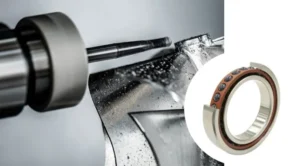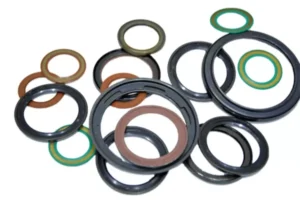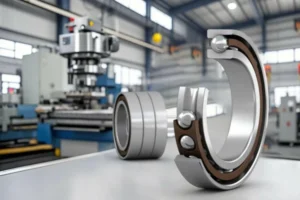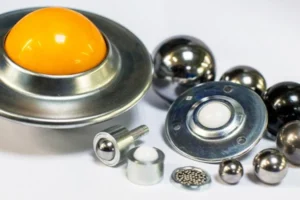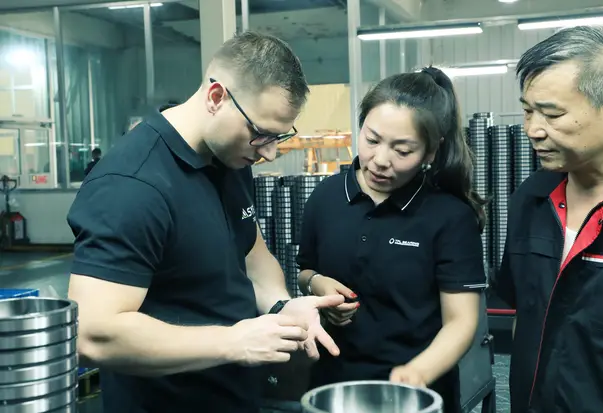Super precision angular contact ball bearings are designed to satisfy the exacting requirements of applications requiring great speed and accuracy. These bearings guarantee precision, longevity, and seamless operation in anything from medical robots to aircraft.
Let’s examine their special benefits and how they work better than conventional bearings.
What Makes Super Precision Angular Contact Bearings Unique?
Engineering Design & Tolerance Standards
Super precision bearings are built to strict tolerance levels like ABEC-7 or ISO P4/P2 standards.
Unlike regular bearings, they use advanced materials like nitrogen-treated steel or hybrid ceramic balls. This reduces wear and ensures consistent performance under stress.
| Parameter | Standard Bearings | Super Precision Bearings |
|---|---|---|
| Radial Runout | ≥0.005mm (ABEC-1 / ISO P0) | ≤0.001mm (ABEC-7 / ISO P4-P2) |
| Surface Roughness | 0.1μm Ra | ≤0.01μm Ra (Mirror Finish) |
| Vibration Level | ISO 1940 G6.3-G2.5 | ISO 1940 G0.4-G1.0 |
5 Key Advantages of Super Precision Angular Contact Ball Bearings
1: Ultra-High Speed Capability with Minimal Friction
The asymmetric raceway design reduces ball skidding, allowing speeds up to 28,000 RPM—nearly double the limits of standard bearings.
Formula: n = (dm × Kw)/10^7, where dm is the pitch diameter and Kw is the material factor.
2: Exceptional Rigidity for Micro-Vibration Control
Preload adjustments (fixed vs. spring-loaded) enhance rigidity.
For example, machine tools using these bearings achieve surface roughness as low as Ra 0.2μm, ideal for optical lens grinding.
3: Optimized Heat Dissipation & Thermal Stability
Super precision bearings stay cooler, with temperature rises as low as 12°C under load, compared to 35°C in standard bearings. Oil-air lubrication systems (1:5–1:10 ratio) further boost heat control.
4: Multi-Directional Load Handling Capacity
The contact angle (α) determines load distribution. For instance, a 25° angle handles combined axial and radial loads efficiently using Fa/Fr = tanα (Fa = axial load, Fr = radial load).

5: Smart Monitoring for Precision Maintenance
Embedded sensors (e.g., piezoelectric) predict failures, reducing downtime by 67%. Real-time data helps adjust preloads and lubrication.
Image suggestion: Dashboard example showing sensor data trends.
Industry-Specific Applications
Machine Tool Spindles: Achieving <0.001mm Runout
In CNC machining, these bearings maintain precision even at 20,000 RPM, which is critical for aerospace parts.
Medical Robotics: Ensuring Sterility & Reliability
FDA-approved lubricants and vacuum-safe designs make them ideal for surgical robots.

Alt Text: "A surgical robot arm using super precision angular contact ball bearings (ABEC-7/P4 rated) for micron-level accuracy in medical procedures.“
How to Select the Right Bearing
Matching Contact Angles to Loads
- 15°: Light axial loads (e.g., pumps).
- 25°: Combined loads (e.g., spindles).
- 40°: Heavy axial loads (e.g., gearboxes).
Preload Guidelines
| Preload Type | Stiffness | Application |
|---|---|---|
| Light | Moderate | High-speed motors |
| Heavy | High | Machine tools |
Choose the Suitable Material
| Characteristic | Ceramic Bearings | Chrome Steel Bearings | Stainless Steel Bearings |
|---|---|---|---|
| Max Speed | ★★★★★ (35k rpm) | ★★★★☆ (18k rpm) | ★★★☆☆ (12k rpm) |
| Noise/Vibration | ★★☆☆☆ (25-30 dB) | ★★★☆☆ (35-45 dB) | ★★★★☆ (40-50 dB) |
| Electrical Resistance | ✔️ Insulated (>1000MΩ) | × (Conductive) | × (Conductive) |
| Maintenance Cycle | 5000 hours (Dry Film) | 2000 hours (Grease) | 1500 hours (Oil) |
| Cost Level | ★★★★★ (Premium) | ★☆☆☆☆ (Most Affordable) | ★★★☆☆ (Mid-Range) |
| High Temp Resistance | 800℃ Air 1200℃ Inert Gas | 150℃ Standard 300℃ Treated | 300℃ Standard 500℃ Enhanced |
| Thermal Sensitivity | -3% lifespan/100℃↑ | -8% lifespan/10℃↑ | -12% lifespan/10℃↑ |
| Cost-Effectiveness | ★★☆☆☆ (Specialized) | ★★★★★ (Industrial) | ★★★☆☆ (Corrosive Environments) |
Maintenance Tips
Lubrication Best Practices
Fill 25–35% of the bearing space with grease. High-temperature environments require synthetic oils.
Vibration Analysis
Regular checks using SKF’s vibration standards (≤0.4 mm/s for precision equipment) prevent failures.
FAQs
Can They Work in Cryogenic Environments?
Yes, with special steels tested at -196°C (Source: Cryogenic Bearing Study, 2020).
Recalibration Frequency
Every 2,000 hours or as per OEM guidelines. Use laser alignment tools for accuracy.

